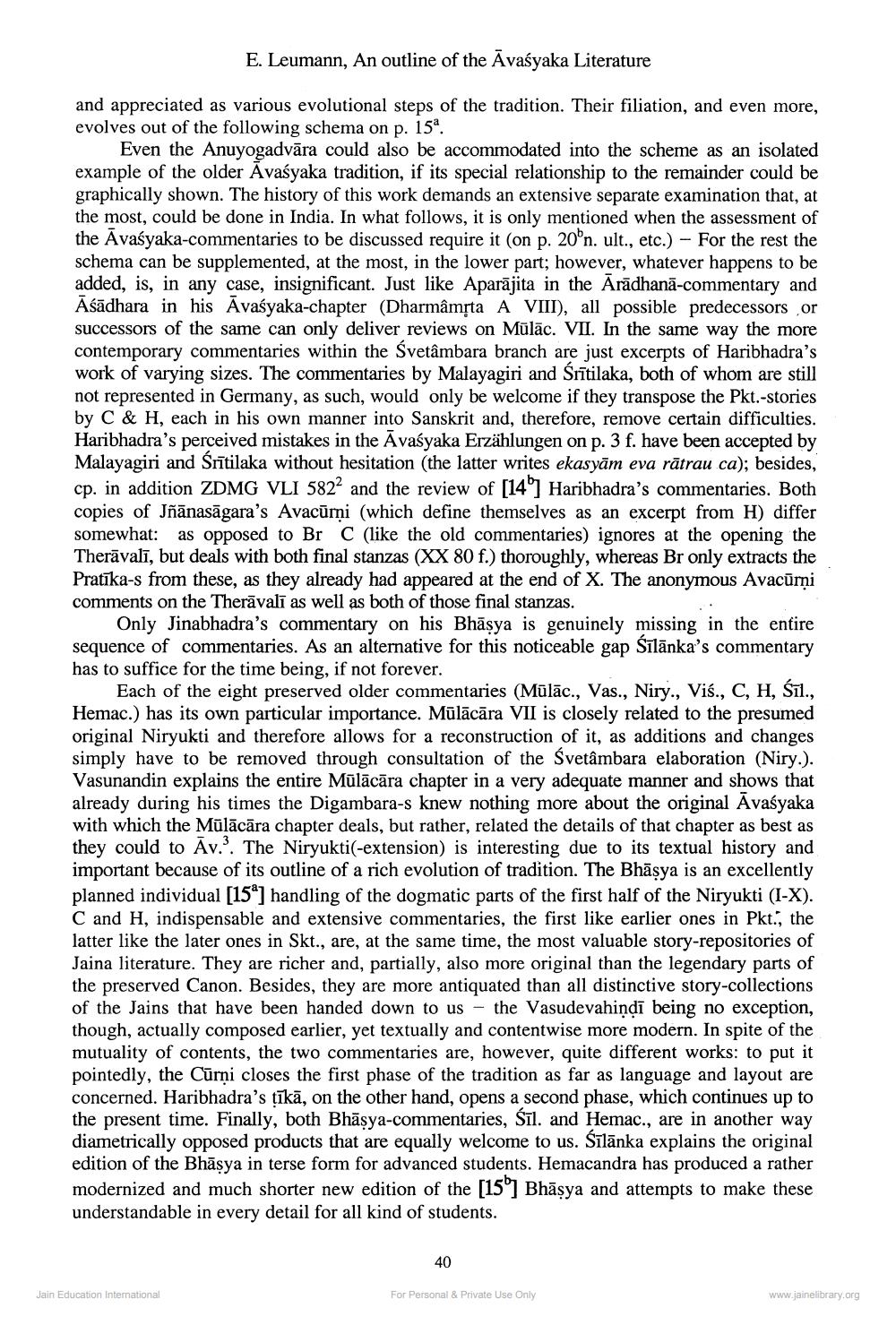________________
E. Leumann, An outline of the Āvaśyaka Literature
and appreciated as various evolutional steps of the tradition. Their filiation, and even more, evolves out of the following schema on p. 154
Even the Anuyogadvāra could also be accommodated into the scheme as an isolated example of the older Avaśyaka tradition, if its special relationship to the remainder could be graphically shown. The history of this work demands an extensive separate examination that, at the most, could be done in India. In what follows, it is only mentioned when the assessment of the Avaśyaka-commentaries to be discussed require it (on p. 20'n. ult., etc.) - For the rest the schema can be supplemented, at the most, in the lower part; however, whatever happens to be added, is, in any case, insignificant. Just like Aparājita in the Ārādhanā-commentary and Āsādhara in his Āvasyaka-chapter (Dharmâmsta A VIII), all possible predecessors or successors of the same can only deliver reviews on Mūlāc. VII. In the same way the more contemporary commentaries within the Svetâmbara branch are just excerpts of Haribhadra's work of varying sizes. The commentaries by Malayagiri and Srītilaka, both of whom are still not represented in Germany, as such, would only be welcome if they transpose the Pkt.-stories by C & H, each in his own manner into Sanskrit and, therefore, remove certain difficulties. Haribhadra's perceived mistakes in the Avaśyaka Erzählungen on p. 3 f. have been accepted by Malayagiri and Śrītilaka without hesitation (the latter writes ekasyām eva rātrau ca); besides, cp. in addition ZDMG VLI 5822 and the review of [14] Haribhadra's commentaries. Both copies of Jñānasāgara's Avacūrņi (which define themselves as an excerpt from H) differ somewhat: as opposed to Br C (like the old commentaries) ignores at the opening the Therāvalī, but deals with both final stanzas (XX 80 f.) thoroughly, whereas Br only extracts the Pratīka-s from these, as they already had appeared at the end of X. The anonymous Avacūrņi comments on the Therāvalī as well as both of those final stanzas.
Only Jinabhadra's commentary on his Bhāsya is genuinely missing in the entire sequence of commentaries. As an alternative for this noticeable gap Śīlānka's commentary has to suffice for the time being, if not forever.
Each of the eight preserved older commentaries (Mūlāc., Vas., Niry., Vis., C, H, Śīl., Hemac.) has its own particular importance. Mūlācāra VII is closely related to the presumed original Niryukti and therefore allows for a reconstruction of it, as additions and changes simply have to be removed through consultation of the Svetâmbara elaboration (Niry.). Vasunandin explains the entire Mulācāra chapter in a very adequate manner and shows that already during his times the Digambara-s knew nothing more about the original Avasyaka with which the Mülācāra chapter deals, but rather, related the details of that chapter as best as they could to Av.'. The Niryukti(-extension) is interesting due to its textual history and important because of its outline of a rich evolution of tradition. The Bhāsya is an excellently planned individual [159] handling of the dogmatic parts of the first half of the Niryukti (I-X). C and H, indispensable and extensive commentaries, the first like earlier ones in Pkt., the latter like the later ones in Skt., are, at the same time, the most valuable story-repositories of Jaina literature. They are richer and, partially, also more original than the legendary parts of the preserved Canon. Besides, they are more antiquated than all distinctive story-collections of the Jains that have been handed down to us – the Vasudevahindī being no exception, though, actually composed earlier, yet textually and contentwise more modern. In spite of the mutuality of contents, the two commentaries are, however, quite different works: to put it pointedly, the Cūrni closes the first phase of the tradition as far as language and layout are concerned. Haribhadra's tīkā, on the other hand, opens a second phase, which continues up to the present time. Finally, both Bhāsya-commentaries, Śīl. and Hemac., are in another way diametrically opposed products that are equally welcome to us. Šīlānka explains the original edition of the Bhāsya in terse form for advanced students. Hemacandra has produced a rather modernized and much shorter new edition of the [150] Bhāsya and attempts to make these understandable in every detail for all kind of students.
40
Jain Education International
For Personal & Private Use Only
www.jainelibrary.org




